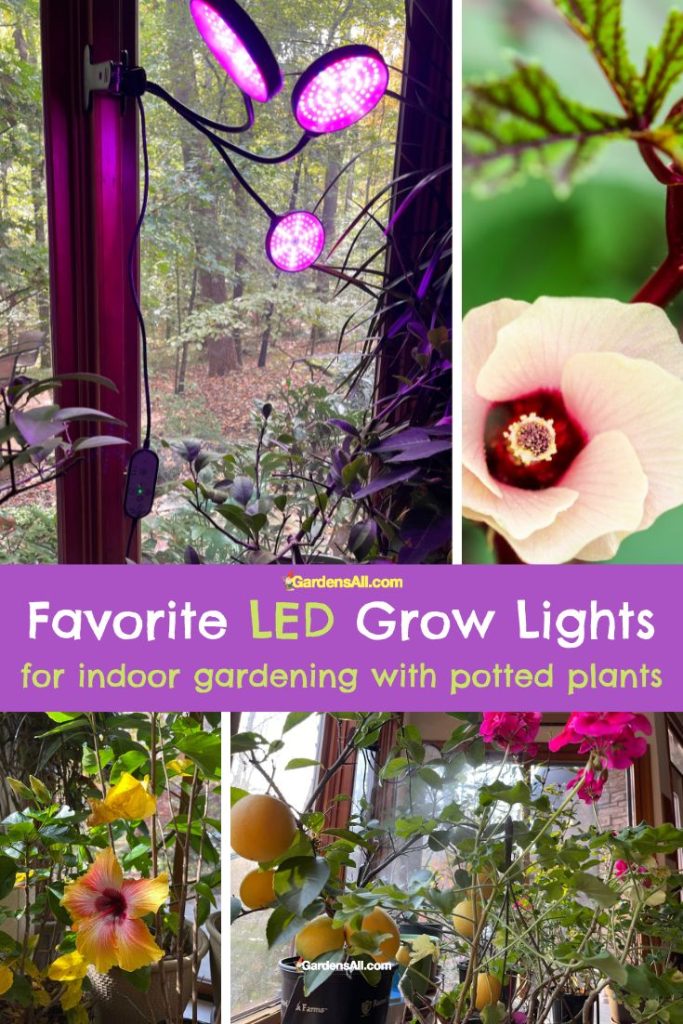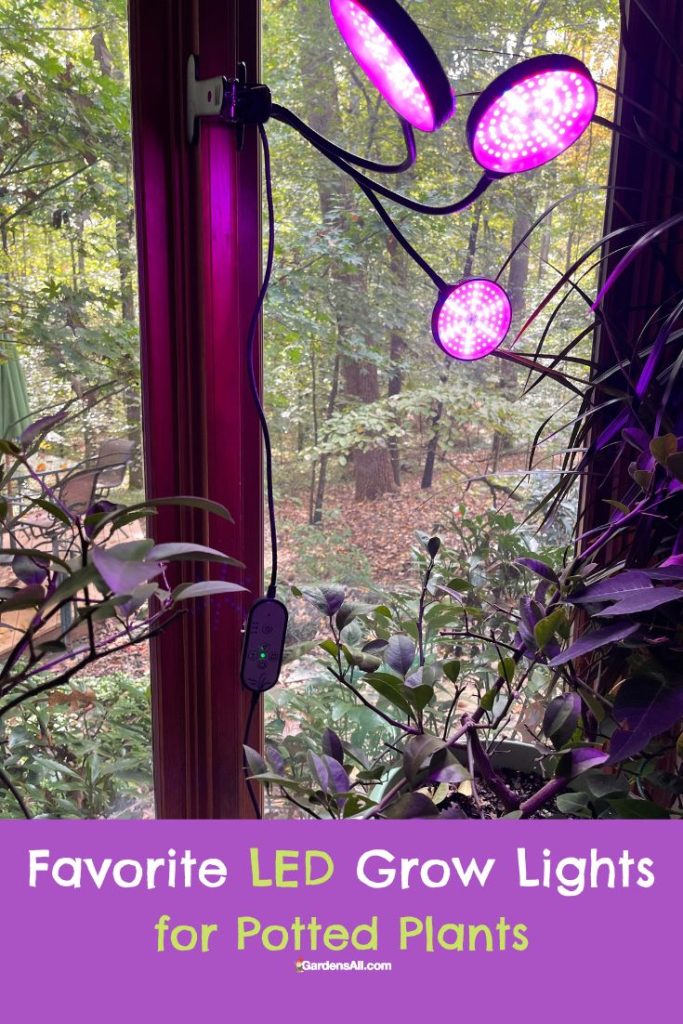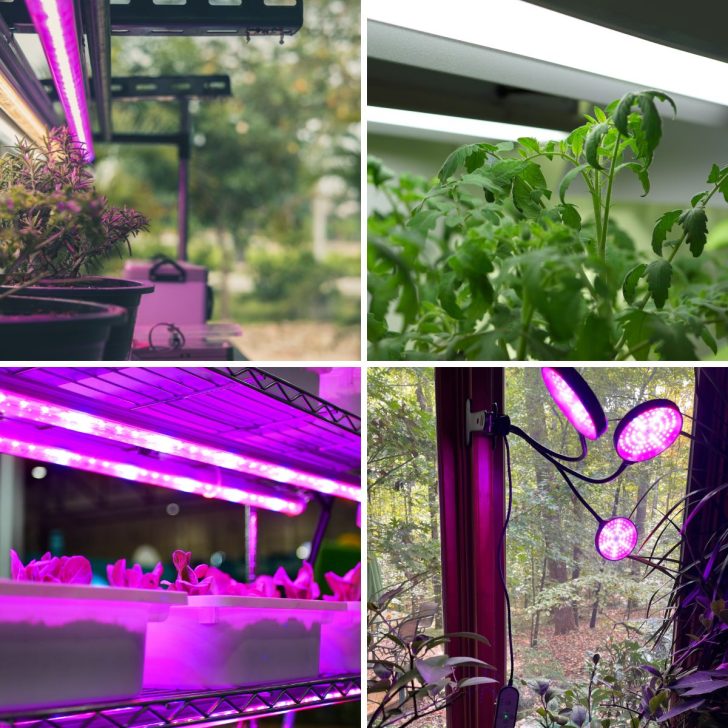Indoor Gardening With Grow Lights
Because Growers Gotta Grow
Gardeners get addicted to having fresh food readily available. For people who love the idea of growing their own food year round, LED grow lights may be the best solution.
Indoor plant lighting systems can be pricey, so which are the best grow lights? We delve into this topic here, and include economical hacks from GardensAll community members to help you decide on the best grow light system for you.
From Basements to Outer Space
Grow lights are localized lights that deliver very specific light and heat to the plants in order to make them grow. This technology has been used by NASA, the government, and farmers all over the world.
While they can be a little pricey and require getting used to this style of gardening, it can be helpful and productive for people who want to keep on growing more of their own food. And, there are less expensive grow light hacks shared by some of our community members here as well.
Adjustable Gooseneck Clip-on LED Grow Light 15-60W
This is our favorite LED grow light, which we use for our indoor plants in winter. There’s currently just one company selling these on Amazon with 4.5 star reviews overall.
These LED grow lights are reasonably priced and come with the option of a single light of 15 watts, or up to four adjustable gooseneck light disks on one system, for up to 45 watts. We have three lights, so 30 watts total.
This means that you can clip them to one location, and position as needed. Ours are clipped to the window trim, and positioned over Meyer lemon trees, roselle, and poinsettia bushes.
We love the portability and flexibility of this simple clip-on LED grow light.

Sun System HPS 150 Grow Light Fixture

With an incredibly 16,000 lumens and a color spectrum that is designed for growing indoor plants, Sun System HPS 150 Grow Light Fixture is an efficient light that won’t have a huge impact on your electricity bill. The lights are silent as well, so you won’t have to worry about the humming that you could hear with others.
Installation is another benefit for this one: it comes with a hanger on each end and a battery already in place. Even though there is ventilation and the aluminum structure dissipates heat, make sure that you hang it safely.
You can find this on Amazon.
TaoTronics TT-E27 24 Watt
If going green is one of your main reasons for growing food or plants, this one might be an option for you as well. Without using a lot of electricity, you are able to get a full spectrum, 3 band ratio that gives off plenty of light. Part of that is because the light has a built in fan that removes the heat. Better yet, you are able to use this particular light throughout all stages of growth.
You can find this on Amazon.
iPower Digital Dimmable Grow Light System for Plants

There is some personalization within the iPower, which is why it lands on this list. You can use one HPS (high pressure sodium) bulb or two that have either 400, 600, or 1,000 watts of power. But that isn’t the end of the personalization, as you can also dim them by 50%, 75%, or 100% for when you don’t need heat.
According to a description from the company, the “balanced spectrum set of lights will not only be well-absorbed by plant-feets chlorophylls, but also promotes healthy chlorophyll production, and regulates plant life cycle”.
You can find this on Amazon.
Advanced Platinum Series DS200 300 Watt

If getting the latest piece is something that you are looking for, the Advanced Platinum Series DS200 300 Watt grow light is the baby of the list.
Many like this product because it doesn’t produce a lot of heat, which means that it is very efficient and provides only usable light so that photosynthesis is strong and works well. There is personalization here as well, you can set the lights for vegetables and flowers, which means that you can have optimal growth for all of it. It is a little more technical, but the instruction manual is very easy to understand.
Hydrofarm FLT24 4-Tube T5 Commercial System

Hydrofarm is a very trusted name in the manufacturing of hydroponic or aquaponics gardening equipment. The reason their grow light is one of the best is because the 6400K T5 bulbs put out double the amount of light of a normal fluorescent system.
These lights are also versatile in that they can be hung in three different ways: horizontally, vertically, or overhead, which allows you to position them in a way that best suits your space and your plants.
You can find this on Amazon.
Something for Every Need
There are tons of other grow lights on the market today, making it easy to find the solution that fits your specific needs, but these are some of the best sellers on the market today. To decide which one is right for you, just look seriously at what you want to grow, how you want to grow, and what your budget will be.
The good news is that the money you will save on groceries bills will help to pay for the grow lights. And it’s hard to put a price on the benefit of the freshest food in the world!
Many who utilize indoor grow lights look for ways to expand their indoor growing space over time. We even have some longevity spinach growing under LEDs in our bathtub!
Which Grow Lights Save on Electricity?
We have quite a conversation going on in the GardensAll Facebook page regarding which grow lights are best and which use the most and least electricity. Here’s a chart that we found on ConnectXcelEnergy.com that’s really helpful and eye-opening!
From ConnectXcelEnergy.com
We’ll need to begin with the amount of light bulbs in a home. According to a recent survey[1]https://ezinearticles.com/?How-Many-Light-Bulbs-Are-In-The-Average-American-Household?&id=6486896, the average American household uses 47 light bulbs.
Electricity Usage in the Average American Household

Cost of Electricity Usage in the Average American Household
Monthly Cost of Using Incandescent Light Bulbs
2.820 X $0.1188 X 150 hours = $50.25
Monthly Cost of Using CFL Bulbs
0.658 X $0.1188 X 150 hours = $11.73
Monthly Cost of Using LED Bulbs
0.447 X $0.1188 X 150 hours = $7.97
If, in this scenario, if I switched 47 incandescent light bulbs to LEDs, I could save around $42.28 each month ($50.25 – $7.97 = $42.28).
That really adds up over the course of a year, and the savings continue to grow over many years. [2]https://connect.xcelenergy.com/minnesota/how-much-money-can-you-save-by-switching-to-energy-efficient-light-

LED Grow Lights for Basement Hydroponics
Frances in Murphy, NC shares her hydroponic setup in her basement.
I have 400 plants actively growing in a hydroponic setup in my basement (plus many plants in my nursery growing). The temperature in my basement is about 65 degrees year round.
We ordered these Barrina LED lights from Amazon for our setup and our plants are doing great!
I am currently growing:
- about twenty types of lettuce
- four types of kale
- three types of swiss chard
- pak choi
It has been quite a process to figure out which lettuce grows best for long periods of time. Most of my lettuce is leaf lettuce that is cut and come again and the lettuce plants usually last about three months before I have to replace them. I am just starting to experiment with head lettuce varieties.
The kale usually lasts five months before replacing.
Masterblend Fertilizer
I am just using Masterblend fertilizer bought from Amazon, 20 gallon mortar mixing bins & rigid foam board insulation bought locally at Home Depot or Lowe’s, & lights (the lights I bought previously online at Lowe’s have been discontinued). I’m using air pumps purchased from Amazon.
Some to Eat and Some to Sell
I am mainly growing the leafy greens for family consumption, selling several bags a week at my homeschool co-op and church.
I sprout the seeds in Oasis cubes. Once the plants get about 1″ tall, I separate the oasis cubes and put the individual cubes in 2″ net cups purchased from Amazon.
My “nursery” is the smaller plants that I am growing out for about three weeks before putting them in the larger hydroponic bins. I have cut holes in rigid 1/2″ foam insulation with a 2′ round hole saw bit.
The foam board goes on top of black plastic 1020 trays with masterblend fertilizer solution and the net cups go in the holes.
Awesome sharing, Frances, and that lettuce looks luscious and yummy!
More Grow Lights Wisdom from the GardensAll Community
Editor’s Note: We got a great economical tip from a GardensAll Facebook community member, Sam Lopez III of 7 Heavenly Hens Garden, a builder, running their own home-grown urban homestead since 2013. They’ve accomplished so much in a short time!
Sam L. : We use typical garage shop lights with cool white bulbs and have great success – for around just $17 each. [3]https://7heavenlyhensgarden.wordpress.com/
Thomas Roth: I just use standard 4 ft, fluorescent lights; mix cool white and bright light for different light spectrum’s. Also keep the light right above the plants or they will get leggy especially new sprouts.
Will H. “I get by pretty well with shop lights with one blue (kitchen) and one red (bath) T5 lights…. ~2-4 inches [from the plants] I think. I’ll be experimenting with enclosing my grow space in mylar and see of that improves growth.
Emily H. “I also use the t5 grow lights. A plant one and a regular one.”
Don G. “I exclusively use LED lighting by Agromax (280 professional series). Yes the initial costs are higher than t5 lighting however, you save a bundle on your electric bill. You get better light spectrums less heat and your plants will love you for it.”
Ashley M. “I used 4 foot shop lights with t12 bulbs in them last year. It was affordable and I had great results!”
Missy G. “I’ve got ten thousand watts of High Intensity Discharge lighting in my main room. I use 8 bulb banks of T-5 lights in the veg room. Those are on pulleys and move up and down. My electric bills are INSANE. I’d like to switch to LED but I worry about wispiness.”
Alex D. “I use T5s, I love them.”
Jay R. “I use T12 as supplemental light to my windows.”
Michael G. “T-5’s are much better and cheaper.”
I would love to grow autumn and winter greens outside…and given that I am in New Mexico, I should be able to do it…but…we are in the midst of extraordinary drought that means that so many critturs eat any and every thing that has moisture no matter what sort of protective devices. I use My summer gardens were totally decimated by rodents..rabbits, mice, packrats no matter my efforts to keep them out.. The critturs are so desperate.
So I am actually starting greens inside under lights. I have 2 set ups, one with a T5 light, one that I am beginning with LED lights.Since I usually keep my living space during the winter at about 65-70 degrees, I expect it will work well.
~Judith Jenness
Okay! So there you have it! A wide array of responses from folks in the trenches… er… in the garden!
For more on what we’re doing with grow lights for seedlings and such, you may also enjoy this article and this one on our newest set up with the indoor greenhouse.

We are an online gardening publication sharing all things garden related! Including urban farming, family gardening, homesteading, gardening for profits, and more. We’re all about growth!
References





